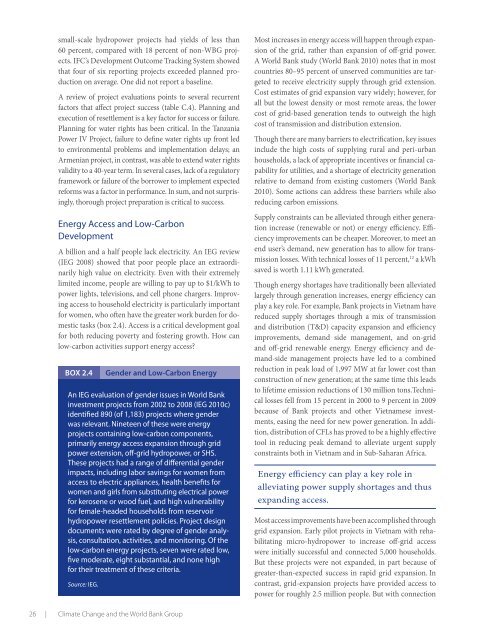The Challenge of Low-Carbon Development - World Bank Internet ...
The Challenge of Low-Carbon Development - World Bank Internet ...
The Challenge of Low-Carbon Development - World Bank Internet ...
You also want an ePaper? Increase the reach of your titles
YUMPU automatically turns print PDFs into web optimized ePapers that Google loves.
small-scale hydropower projects had yields <strong>of</strong> less than60 percent, compared with 18 percent <strong>of</strong> non-WBG projects.IFC’s <strong>Development</strong> Outcome Tracking System showedthat four <strong>of</strong> six reporting projects exceeded planned productionon average. One did not report a baseline.A review <strong>of</strong> project evaluations points to several recurrentfactors that affect project success (table C.4). Planning andexecution <strong>of</strong> resettlement is a key factor for success or failure.Planning for water rights has been critical. In the TanzaniaPower IV Project, failure to define water rights up front ledto environmental problems and implementation delays; anArmenian project, in contrast, was able to extend water rightsvalidity to a 40-year term. In several cases, lack <strong>of</strong> a regulatoryframework or failure <strong>of</strong> the borrower to implement expectedreforms was a factor in performance. In sum, and not surprisingly,thorough project preparation is critical to success.Energy Access and <strong>Low</strong>-<strong>Carbon</strong><strong>Development</strong>A billion and a half people lack electricity. An IEG review(IEG 2008) showed that poor people place an extraordinarilyhigh value on electricity. Even with their extremelylimited income, people are willing to pay up to $1/kWh topower lights, televisions, and cell phone chargers. Improvingaccess to household electricity is particularly importantfor women, who <strong>of</strong>ten have the greater work burden for domestictasks (box 2.4). Access is a critical development goalfor both reducing poverty and fostering growth. How canlow-carbon activities support energy access?Box 2.4An IEG evaluation <strong>of</strong> gender issues in <strong>World</strong> <strong>Bank</strong>investment projects from 2002 to 2008 (IEG 2010c)identified 890 (<strong>of</strong> 1,183) projects where genderwas relevant. Nineteen <strong>of</strong> these were energyprojects containing low-carbon components,primarily energy access expansion through gridpower extension, <strong>of</strong>f-grid hydropower, or SHS.<strong>The</strong>se projects had a range <strong>of</strong> differential genderimpacts, including labor savings for women fromaccess to electric appliances, health benefits forwomen and girls from substituting electrical powerfor kerosene or wood fuel, and high vulnerabilityfor female-headed households from reservoirhydropower resettlement policies. Project designdocuments were rated by degree <strong>of</strong> gender analysis,consultation, activities, and monitoring. Of thelow-carbon energy projects, seven were rated low,five moderate, eight substantial, and none highfor their treatment <strong>of</strong> these criteria.Source: IEG.Gender and <strong>Low</strong>-<strong>Carbon</strong> EnergyMost increases in energy access will happen through expansion<strong>of</strong> the grid, rather than expansion <strong>of</strong> <strong>of</strong>f-grid power.A <strong>World</strong> <strong>Bank</strong> study (<strong>World</strong> <strong>Bank</strong> 2010) notes that in mostcountries 80–95 percent <strong>of</strong> unserved communities are targetedto receive electricity supply through grid extension.Cost estimates <strong>of</strong> grid expansion vary widely; however, forall but the lowest density or most remote areas, the lowercost <strong>of</strong> grid-based generation tends to outweigh the highcost <strong>of</strong> transmission and distribution extension.Though there are many barriers to electrification, key issuesinclude the high costs <strong>of</strong> supplying rural and peri-urbanhouseholds, a lack <strong>of</strong> appropriate incentives or financial capabilityfor utilities, and a shortage <strong>of</strong> electricity generationrelative to demand from existing customers (<strong>World</strong> <strong>Bank</strong>2010). Some actions can address these barriers while alsoreducing carbon emissions.Supply constraints can be alleviated through either generationincrease (renewable or not) or energy efficiency. Efficiencyimprovements can be cheaper. Moreover, to meet anend user’s demand, new generation has to allow for transmissionlosses. With technical losses <strong>of</strong> 11 percent, 12 a kWhsaved is worth 1.11 kWh generated.Though energy shortages have traditionally been alleviatedlargely through generation increases, energy efficiency canplay a key role. For example, <strong>Bank</strong> projects in Vietnam havereduced supply shortages through a mix <strong>of</strong> transmissionand distribution (T&D) capacity expansion and efficiencyimprovements, demand side management, and on-gridand <strong>of</strong>f-grid renewable energy. Energy efficiency and demand-sidemanagement projects have led to a combinedreduction in peak load <strong>of</strong> 1,997 MW at far lower cost thanconstruction <strong>of</strong> new generation; at the same time this leadsto lifetime emission reductions <strong>of</strong> 130 million tons.Technicallosses fell from 15 percent in 2000 to 9 percent in 2009because <strong>of</strong> <strong>Bank</strong> projects and other Vietnamese investments,easing the need for new power generation. In addition,distribution <strong>of</strong> CFLs has proved to be a highly effectivetool in reducing peak demand to alleviate urgent supplyconstraints both in Vietnam and in Sub-Saharan Africa.Energy efficiency can play a key role inalleviating power supply shortages and thusexpanding access.Most access improvements have been accomplished throughgrid expansion. Early pilot projects in Vietnam with rehabilitatingmicro-hydropower to increase <strong>of</strong>f-grid accesswere initially successful and connected 5,000 households.But these projects were not expanded, in part because <strong>of</strong>greater-than-expected success in rapid grid expansion. Incontrast, grid-expansion projects have provided access topower for roughly 2.5 million people. But with connection26 | Climate Change and the <strong>World</strong> <strong>Bank</strong> Group
















